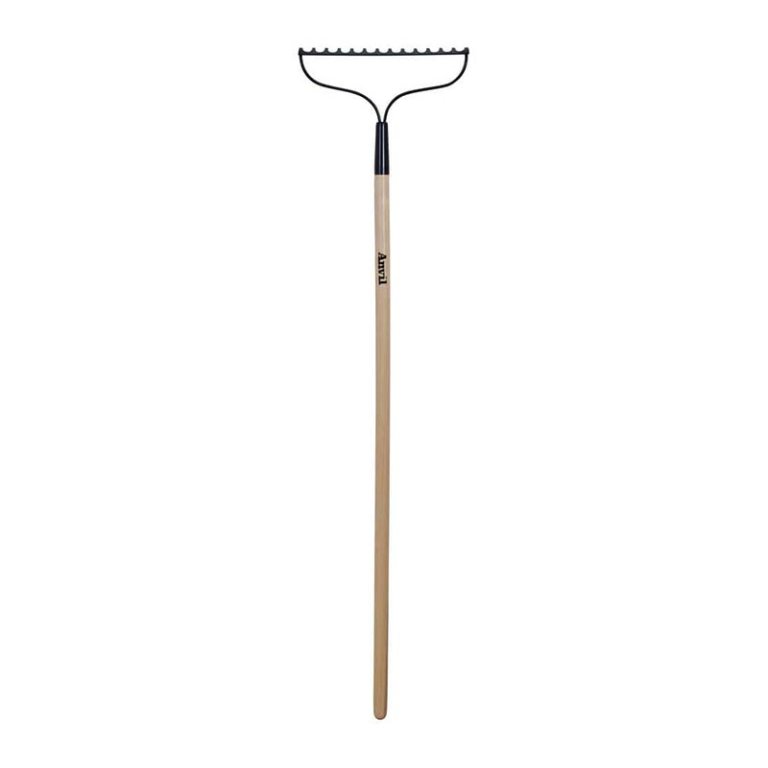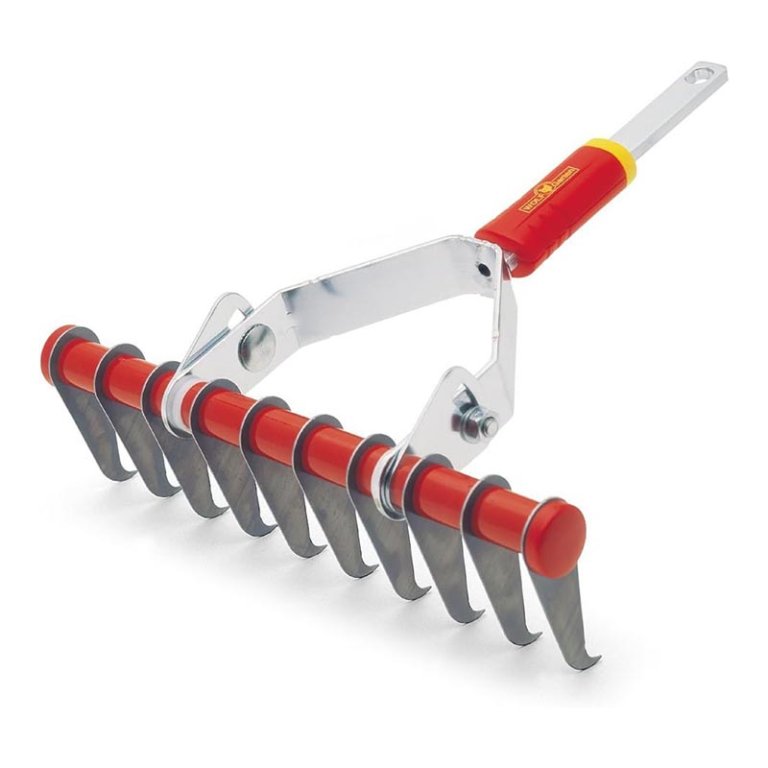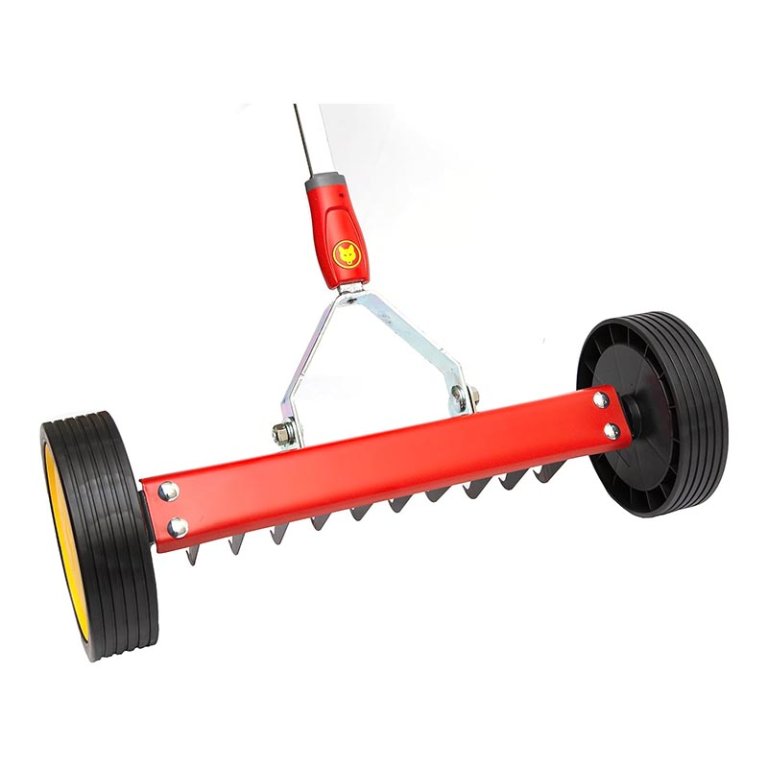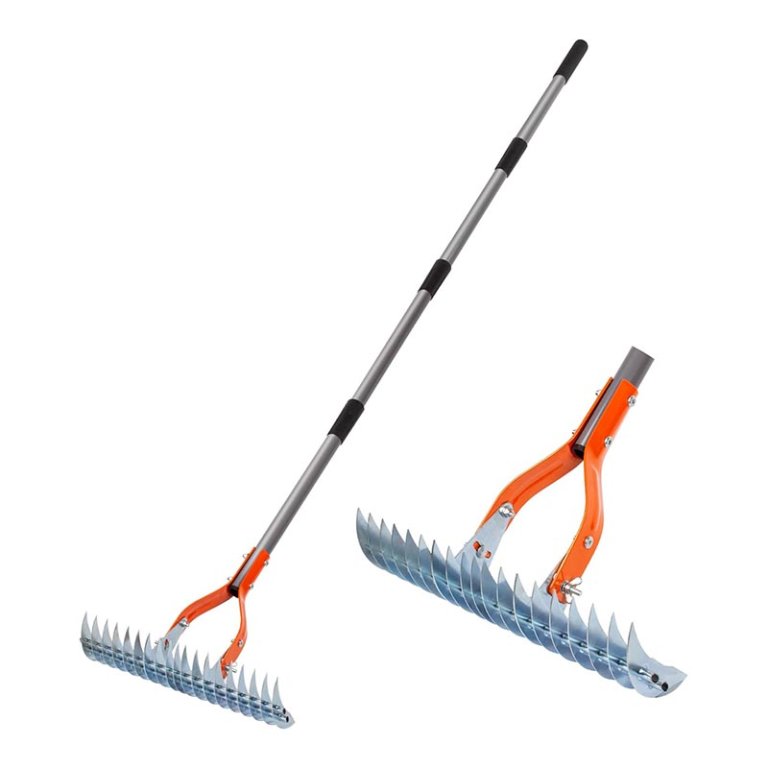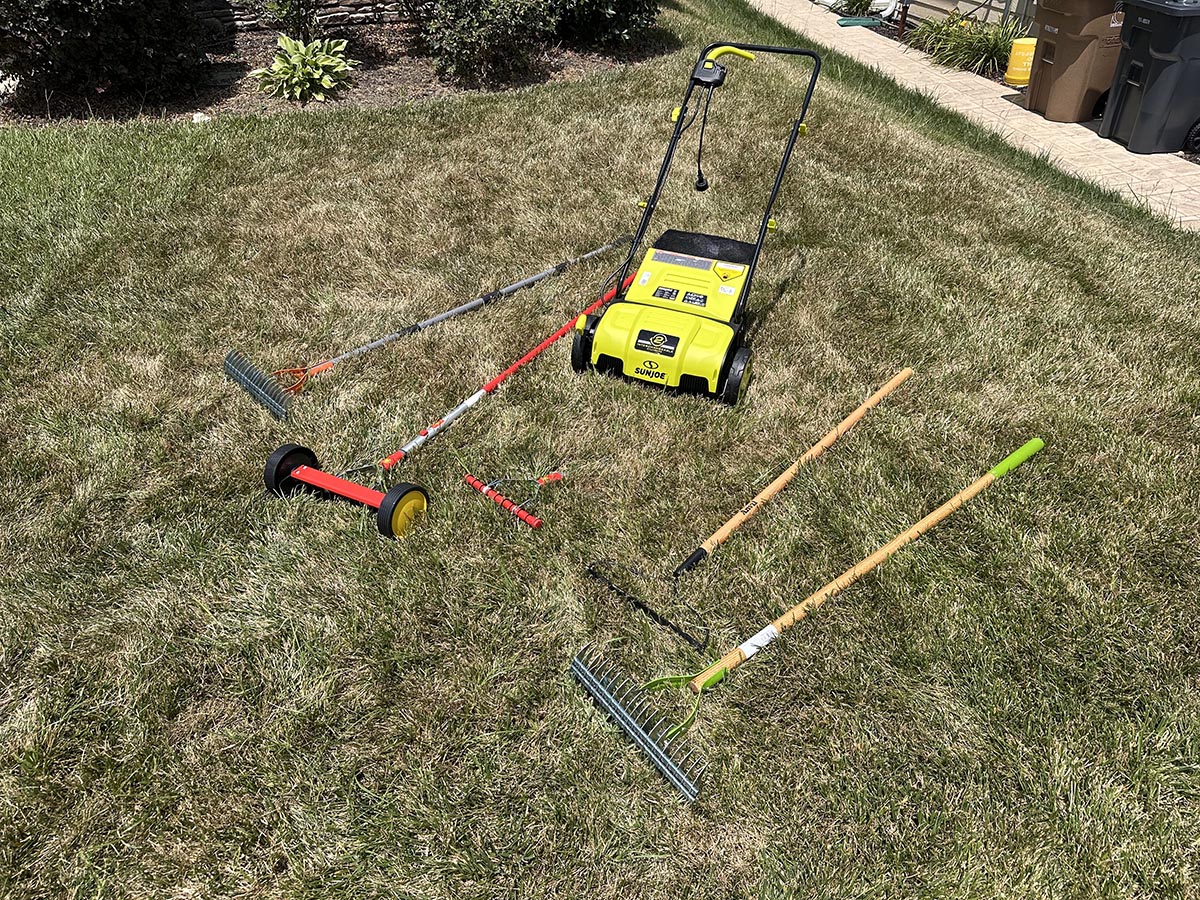
We may earn revenue from the products available on this page and participate in affiliate programs. Learn More ›
Without the benefit of dethatching rakes, dead grass clippings can accumulate between the blades of grass and soil, creating a layer known as thatch. While a thin ½-inch layer of thatch can provide much-needed nutrients, a buildup of 1 inch or more prevents nutrients and water from reaching the soil, stifling healthy growth. When that happens, a good lawn dethatching rake effectively removes the buildup of grass.
The best dethatching rake will have a head with curved steel tines that dig into the thatch layer and lift it away from the landscaping. This head is connected to a sturdy hardwood or fiberglass handle long enough to provide the leverage necessary to remove the thatch.
After testing six dethatching rakes, our top choice was the Ames 15″ Adjustable Thatch Rake. It’s effective at removing thatch, affordable, and built to last. Ahead, discover how the other models we tested performed and learn which features matter most when choosing among the best dethatching rakes for your yard.
- BEST OVERALL: Ames 15″ Adjustable Thatch Rake
↓ Jump to Review - BEST BANG FOR THE BUCK: Anvil 51″ Wood Handle Steel 14-Tine Bow Rake
↓ Jump to Review - BEST DESIGN: Wolf-Garten Interlocken Dethatching Rake
↓ Jump to Review - BEST WITH WHEELS: Wolf-Garten Scarifying Roller Rake
↓ Jump to Review - ALSO CONSIDER: Walensee 15″ Thatch Rake With Adjustable Steel Handle
↓ Jump to Review
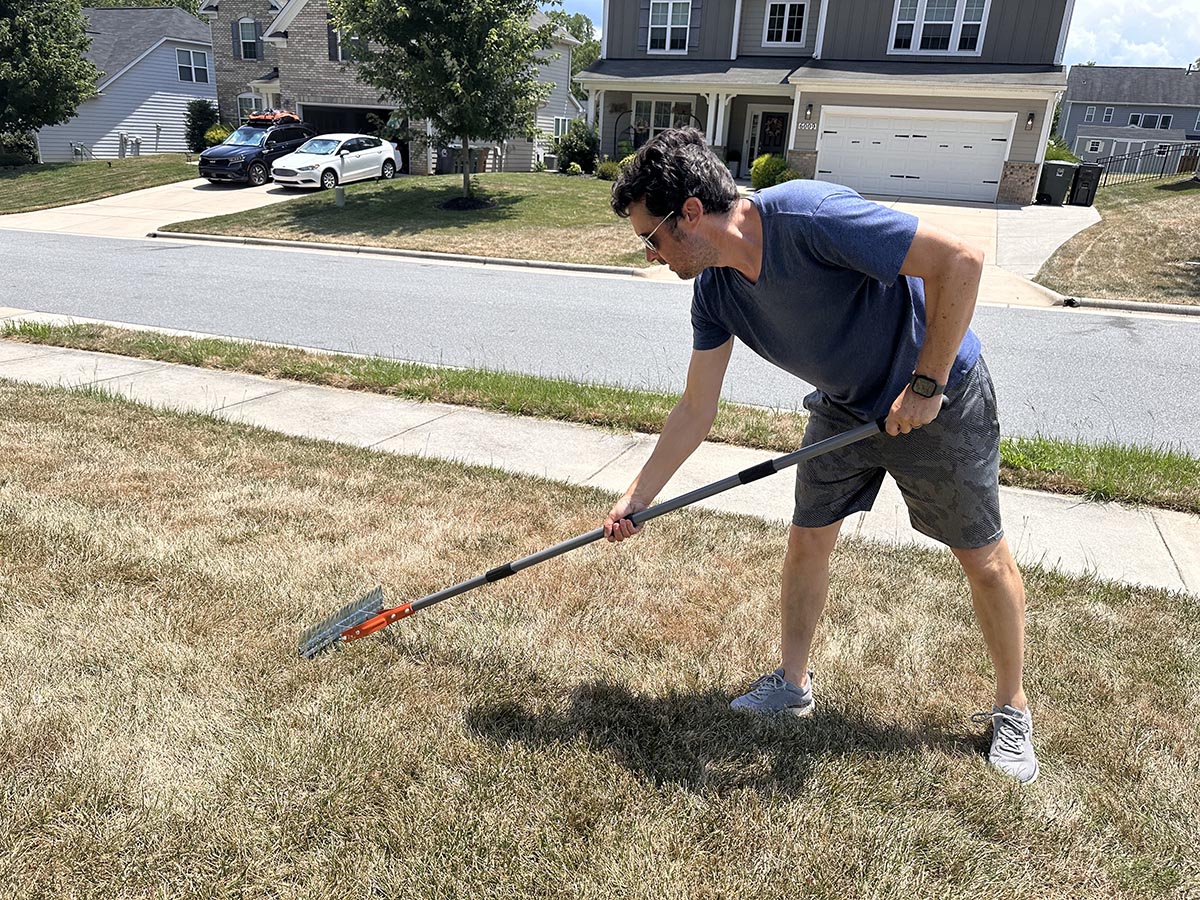
Dethatching Rakes Comparison
| Product | Type | Head Width | Handle |
|---|---|---|---|
| Ames 15″ Adjustable Thatch Rake | Manual | 15 inches | Hardwood with rubber grip |
| Anvil 51″ Wood Handle Steel 14-Tine Bow Rake | Manual | 13.75 inches | Hardwood with rubber grip |
| Wolf-Garten Interlocken Dethatching Rake | Manual | 12 inches | Sold separately |
| Wolf-Garten Scarifying Roller Rake | Manual | 14.96 inches | Sold separately |
| Walensee 15″ Thatch Rake With Adjustable Steel Handle | Manual | 15 inches | Steel |
Our Top Picks
These lawn thatching tools are all built with durable materials and effective designs for removing thatch. As the best dethatchers we tested, one is likely to be an excellent choice for keeping your lawn healthy.
Best Overall
Ames 15" Adjustable Thatch Rake
Buy at AmazonWhat We Like
- Sturdy construction
- Well-designed curved and pointed tines
- Adjustable head
What We Don’t Like
- Durable materials make for a heavier rake
Product Specs
- Type: Manual
- Head width: 15 inches
- Handle: Hardwood with rubber grip
Our Ratings: Ease of Use 4/5; Effectiveness 4.5/5; Durability 5/5; Value 4.5/5
The smart design and sturdy construction of this Ames adjustable hand-thatching rake make it an ideal option for dealing with excess thatch buildup and bare spots in lawns. Though it looks similar to other manual dethatching tools, its unique head and tines set its performance apart from the rest. The formidable-looking curved tines taper to sharp points, making them perfect for pulling up thatch without causing any damage.
However, there is a learning curve to using this rake for thatching a lawn. I started my testing with the head adjusted at too aggressive an angle, which caused me to accidentally pull out a sizable amount of turf. Tweaking my approach resolved that issue and allowed me to remove impressive amounts of thatch. The cushioned grip on the hardwood handle made the rake comfortable in my hands, but I will say such durable materials did make this pick heavier than lighter-duty models.
What our tester says: “Now that I’ve figured out the right head angle, this rake has become my favorite tool for dethaching manually. It’s affordable and well built, plus it removes a surprising amount of thatch with each pull.”—Tony Carrick, Product Reviews tester and writer
Get the Ames dethatching rake at Amazon or The Home Depot.
Best Bang for the Buck
Anvil 51" Wood Handle Steel 14-Tine Bow Rake
Buy at The Home DepotWhat We Like
- Budget-friendly price
- Also makes a great gardening tool and gravel spreader
- Durable steel and hardwood construction
What We Don’t Like
- Not as effective as a dethatching rake
Product Specs
- Type: Manual
- Head width: 13.75 inches
- Handle: Hardwood with rubber grip
Our Ratings: Ease of Use 4.5/5; Effectiveness 5/5; Durability 4/5; Value 4.5/5
Unlike the other rakes and dethatching machines I tested, Anvil’s bow rake is not specifically designed for removing thatch. That’s probably why I was so surprised by just how effective it was for the task. Once I found the right angle, I was able to pull up ample amounts of thatch while leaving green grass relatively unscathed. The handle felt sturdy in my hands, and the metal head seemed durable enough to last through several seasons.
As much as I liked the Anvil, I wouldn’t say dethatching with it was easy—removing thatch with bow rakes requires more physical effort than tools explicitly made for the job. But since you can use it for other landscaping tasks and it costs far less than a specialized tool, it’s an excellent rake if you have a smaller lawn or a relatively minor thatch issue. In those instances, a more versatile and budget-friendly choice like this just makes more sense.
Get the Anvil dethatching rake at The Home Depot.
Best Design
Wolf-Garten Interlocken Dethatching Rake
Buy at AmazonWhat We Like
- Thin, curved tines cause virtually no damage
- Sturdy steel construction
- Adjustable head angle
What We Don’t Like
- Handle is sold separately
Product Specs
- Type: Manual
- Head width: 12 inches
- Handle: Sold separately
Our Ratings: Ease of Use 4.5/5; Effectiveness 5/5; Durability 5/5; Value 3.5/5
The wide design and hooked tines on this Wolf-Garten dethatching rake make it one of the best tools for removing dead grass from a suffocated lawn. During testing, it pulled up thatch easily without causing unnecessary damage. The adjustable head allowed me to find the optimal tine angle, and although I had to purchase a Wolf-Garten handle separately, I found it to be one of the easier manual dethatcher rakes to operate. That said, it does offer less coverage than other manual rakes: The head is just 12 inches wide, narrower than the 15-inch versions that come relatively standard on these tools.
While this dethatching rake features top-notch build quality, it is also one of the priciest models once you add a handle. The upside is that the rake head is part of Wolf-Garten’s Interlocken system, which allows you to attach and detach various tool heads to the same handle. If you plan on buying other Wolf-Garten heads, investing in this rake head and handle makes sense. If not, you can find a more affordable option that will be just as effective.
Get the Wolf-Garten Interlocken dethatching rake at Amazon.
Best with Wheels
Wolf-Garten Scarifying Roller Rake
Buy at AmazonWhat We Like
- Wheels make it easier to operate
- Keeps tines at a consistent height
- Durable steel construction
What We Don’t Like
- Tines are a bit narrow and handle is sold separately
Product Specs
- Type: Manual
- Head width: 14.96 inches
- Handle: Sold separately
Our Ratings: Ease of Use 4/5; Effectiveness 4/5; Durability 5/5; Value 3.5/5
Like most manual dethatching rakes, the Wolf-Garten scarifying roller rake has a set of sturdy curved tines that dig into a lawn and pull out thatch. Unlike most manual models, however, it sits on two wheels—meaning instead of using a repeated raking motion, you simply roll it across the lawn to lift offending thatch.
During testing, the wheels added a couple of obvious benefits. First, they kept the rake at a consistent height, making it easier to remove excess thatch without damaging healthy grass. Also, since the wheels support the head, using this rake was less physically demanding than a fully manual model, though removing thick thatch still requires a fair amount of effort. As with the other Wolf-Garten rake I tested, it has an exceptional build quality with durable stainless steel construction.
While the wheels are a smart and effective design, this scarifying roller rake is quite pricey since you have to buy a handle separately. However, it’s also part of Wolf-Garten’s Interlocken system, so the handle will work with a host of other tool heads. If you like the idea of some extra support for a tough job and plan on investing in other Wolf-Garten heads, this manual dethatcher on wheels is a solid choice.
Get the Wolf-Garten scarifying dethatching rake at Amazon.
Also Consider
Walensee 15" Thatch Rake With Adjustable Steel Handle
Buy at Amazon Buy at The Home Depot Buy at WalmartWhat We Like
- Lightweight design
- Adjustable head angle and handle length
- Tines removing thatch very effectively
What We Don’t Like
- Head wing nuts can loosen while raking
Product Specs
- Type: Manual
- Head width: 15 inches
- Handle: Steel
Our Ratings: Ease of Use 5/5; Effectiveness 4/5; Durability 4/5; Value 5/5
This well-designed dethatching rake from Walensee features curved tines that dig nicely into the soil, dislodging a significant amount of thatch with each pull. The adjustable head makes it easy to ensure that “just-right” angle without causing damage. The only drawback was the wing-nut adjuster, which tended to loosen over time (even after I tightened it with a wrench), eventually causing the head to move.
This rake has a hollow steel handle that goes together in pieces. While I was skeptical of its stability at first, it was quite strong once assembled. Plus, the hollow handle made for a notably lighter rake than those with hardwood handles. The handle is also nearly 6 feet long, which allowed me to get plenty of leverage for removing thatch. If that’s a bit too much for you to wield, you can shorten it by removing a piece. Overall, this pick is affordable, durable, and effective, making it a great manual option for dethatching a yard.
What our tester says: “The Walensee dethatching rake impressed me with how easily the curved tines pulled up thatch without harming the lawn. Its adjustable head and lightweight hollow steel handle made it both effective and easy to use.”—Tony Carrick, Product Reviews tester and writer
Get the Walensee dethatching rake at Amazon, Lowe’s, The Home Depot, Walmart, or Target.
Jump to Our Top Picks
How We Tested the Best Dethatching Rakes
| Testing Stats | |
| Products tested | 6 |
| Time spent testing | 4 hours |
| Tests performed | 1 |
| Price range | $15 to $190 |
I evaluated the top six dethatching rakes by putting them to the test on my own thatch-laden backyard. I began by marking off evenly sized 20-foot-long by 6-foot-wide strips of turf, assigning one dethatcher to each strip. I then used each rake to remove the thatch in that strip, considering several factors as I tested.
I evaluated each rake’s ability to collect thatch and the amount of damage it inflicted on healthy grass. I considered each rake’s ease of use, taking into account how much physical effort each model demanded of me. Durability and build quality were also part of my evaluation considerations. I noted my observations and scored each option on a rubric, awarding a Best Overall pick and a category to the other recommended rakes based on their strengths.
| Product | Ease of Use | Effectiveness | Durability | Value |
| Ames 15″ Adjustable Thatch Rake | 4 | 4.5 | 5 | 4.5 |
| Anvil 51″ Wood Handle Steel 14-Tine Bow Rake | 4.5 | 5 | 4 | 4.5 |
| Wolf-Garten Interlocken Dethatching Rake | 4.5 | 5 | 5 | 3.5 |
| Wolf-Garten Scarifying Roller Rake | 4 | 4 | 5 | 3.5 |
| Walensee 15″ Thatch Rake With Adjustable Steel Handle | 5 | 4 | 4 | 5 |
What to Consider When Choosing a Dethatching Rake
The best dethatcher rakes are typically relatively simple tools, consisting of a handle attached to a head with metal tines that pull up loose thatch without damaging the healthy grass. The models in this guide are manual, though there are also powered and tow-behind models on the market.
Types of Dethatching Rakes
To find the best rake for dethatching your lawn, you’ll want to consider the different rake types: manual, power, and tow-behind.
Manual
The most affordable type of dethatcher for a lawn is a manual rake, which looks very similar to a standard rake you would use to gather leaves in the yard. However, dethatching rakes have thinner tines specifically designed to bite into the soil and pull up dead grass.
Using a manual rake for dethatching means you have to supply all the effort necessary to remove thatch. This makes them less expensive than power or tow-behind models, and because they don’t have motors and are typically relatively narrow, they also don’t take up much room.
Power
The best power rake looks similar to a small lawn mower, only instead of a spinning blade that cuts grass, it is equipped with a cylinder covered in dethatcher tines. Power rake dethatchers have motors that power the cylinder, which spins through the lawn pulling up dead grass.
A dethatching power rake uses an electric motor and plugs into a standard outlet. Since these models have cords, they have a somewhat limited range, making them more suitable for smaller yards.
Tow Behind
A tow-behind dethatcher consists of a metal frame with several rows of tines that extend beneath it. The frame sits on two wheels and has a hitch that attaches to the back of a riding lawn mower or ATV, which tows the dethatcher.
A tow-behind dethatcher is usually about 4 feet wide, allowing it to cover a broad area with each pass. Some of the best tow-behind dethatchers have handles that allow the operator to adjust the height of the tines. While their width makes these dethatchers suitable for large yards, their bulky size can also make them a bit challenging to maneuver..
Tines
Tines are the metal prongs that extend from a dethatching rake. Unlike a leaf rake that has wide tines to snag leaves, a dethatching rake’s tines are thinner and have tips that pull up thatch without damaging the soil and healthy grass. They’re also typically curved to help them bite into the thatch. Some dethatching rakes also have tines on the opposite side of the head for preparing soil for reseeding.
Since pulling up thatch requires more force than raking leaves, the best rake to dethatch a lawn will generally be made of steel since it’s strong enough to pull up dense layers of dead grass without bending or breaking.
Head
The head of a rake for dethatching a lawn consists of tines and a frame to secure them. A dethatcher rake head typically varies in width between 12 and 15 inches. The wider the head, the more thatch the rake can remove in a single pass.
Keep in mind that a dethatching rake with a wider head and more tines will require more force to pull it through the thatch than one with a narrower head. Some dethatching rakes have adjustable heads that allow the user to change the head’s angle in relation to the handle for more precision while dethatching.
Handle
Grass dethatcher rakes have handles that are thicker than those of a leaf rake. Handles made of hardwood can withstand the force required to pull the rake head through dense thatch without bending or breaking. Handles made of fiberglass will be strong as well, though much lighter and also more expensive. Dethatching rake handles often have a rubber-covered section near the top, allowing users to get a firm, comfortable, and secure grip.
FAQs
If you’re wondering how to measure the amount of thatch in your lawn or if a standard rake will do the job of dethatching a lawn, read on for answers to some of the most popular questions about these lawn care tools.
To see if your lawn has too much thatch, begin by removing a 2-inch deep segment from your yard. Then measure the amount of spongy material between the soil and the green grass. If it’s more than ¾ inch thick, you have too much thatch in your lawn.
Whether or not a dethatching rake is worth it depends on the condition of your lawn. If your lawn frequently has problems with too much thatch, then a dethatching rake can be a good investment for protecting its health.
The best time to dethatch depends on the type of grass you have. For warm-season grasses like Bermudagrass, Zoysia, and St. Augustine, dethatch in late spring to early summer when the grass is actively growing and can recover well. For cool-season grasses like Kentucky bluegrass and tall fescue, dethatch in early spring or early fall, away from extreme heat and potential frost.
You should use a dethatcher every 1 to 3 years. Warm-season grasses may need annual dethatching, whereas cool-season grasses typically only require it every 2 to 3 years. If the thatch is less than ½-inch thick, you can skip it until later in the season or the following year.
No, you should not use a regular leaf rake to remove thatch from a lawn. When you dethatch with a rake, you won’t effectively remove dead grass from the lawn and may damage healthy grass. That said, using a regular metal rake for lawns with minor thatch issues is usually safe.
To help get rid of thatch naturally, make sure the soil under the thatch stays moist. Bag lawn clippings until the problem is under control, then add nitrogen fertilizer to speed up the decomposition process.
Yes, grass will generally grow back after dethatching, but it may look stressed and thin for a few weeks. Proper care, including watering, fertilizing, aerating, and overseeding, can help fill in any bare spots that appear after dethatching.
Yes, you should cut your grass before dethatching. Mowing it slightly shorter than usual will make reaching the thatch layer easier.
Scarifying is more aggressive than dethatching. It cuts deeper into the soil to remove thick thatch and improve aeration and drainage. Dethatching is a gentler process that mainly removes surface thatch and debris as part of routine lawn maintenance.
Meet the Tester
Tony Carrick is a freelance writer specializing in home improvement, landscaping, technology, home security, and design. His articles have been featured on such sites as Angi, Popular Science, Futurism, 360 Reviews by U.S. News & World Report, Domino, and more. Carrick has conducted rigorous product testing on everything from power tools to home security systems to backyard grills. With each review, his goal is to help readers determine whether a product meets their needs and if it is or isn’t worth its price tag.




